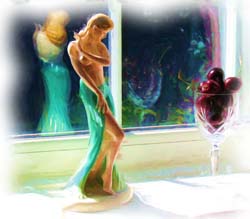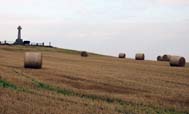The church was built in the 1840s to a neo-Gothic design by architect August Welby Pugin, famous for his work on the Houses of Parliament in Westminster. It was paid for by halfpenny donations from the poorest community of immigrants on Tyneside, and was enhanced in the following decades by bequests from the Dunn family (especially by the addition of a steeple): the Dunns are remembered in several windows. Very recently it has been further beautified by bequests from various benefactors, most notably from Martin Ballinger (d.2007), who paid for the new floor and organ (installed in 2012-13).
A statue of Cardinal Basil Hume (a much loved Archbishop of Westminster) is situated in a memorial garden on the south side of the Cathedral. The garden recalls the Northern Saints and Holy Island (Lindisfarne). The sculpture is the work of Nigel Boonham, a British portrait artist.
The Cardinal Basil Hume Sculpture and Memorial Garden was unveiled by the Queen on 7th May 2002, in the year of Her Majesty’s Golden Jubilee. They were commissioned by the Cardinal Hume Memorial Trust in April 2000 to celebrate Cardinal Hume’s life and work and are situated at the southern end of St. Mary’s Catholic Cathedral, Newcastle upon Tyne, opposite Central Station.
The three-metre bronze sculptures shows Cardinal Hume in his Benedictine monk’s habit, wearing a cardinal’s skullcap and the cross of St. Cuthbert. The statue is set in a garden that reflects his love of the holy landscape of Northumbria and of the Northern Saints and stands on a sandstone platform in the shape of Holy Island (Lindisfarne). Hume welcomes people into the garden, indicating with his left hand the way to Lindisfarne. Nearby is the shape of Inner Farne, the remote island where the first monk-bishops of Lindisfarne, St. Cuthbert and St. Aidan, lived as hermits.
The garden features a small boulder taken from Inner Farne and a three-ton boulder taken from below Lindisfarne Castle inscribed with a facsimile of the Moore Manuscript of the 7th century Cædmon’s Hymn – the earliest Christian poem in Old English. Below the bronze plaque is a stone that was once part of the monks quarters at Ampleforth Abbey, Basil Hume’s monastic home.
The Hymn provides a link to two other Northern Saints admired by Hume: St. Hilda, who encouraged the illiterate herdsman Cædmon to become a monk at Whitby and St. Bede who told his story. The translation contains references to a landscape made by God and is the inspirational key to the design of the garden.
The memorial garden is a space for peaceful contemplation with levels of spiritual symbolism that reflect Basil Hume’s life and work. Each level is progressively higher and smaller in area, representing the proportion of men, physically and spiritually, in each state. Hume admired the hermits but his symbolic place in on Lindisfarne as a man of the church acting as a spiritual beacon, indicating the path to the land God made for man.*
Cædmon’s Hymn
Northumbrian Dialect
Nu scilun herga/hefenricæs uard,
metudæs mehti/and his modgithanc,
uerc uuldurfadur/sue he uundra gihuæs,
eci dryctin,/or astelidæ;
he ærist scop/ældu barnum
hefen til hrofe,/halig scepen,
tha middingærd/moncynnæs uard;
eci dryctin/æfter tiadæ
firum foldu, frea allmehtig.
English Translation
It is meet that we worship/the Warden of heaven,
The might of the Maker,/His purpose of mind,
The Glory-Father’s work/when of all His wonders
Eternal God/ made a beginning.
He earliest established/for earth’s children
Heaven for a roof,/the Holy Shaper;
Then mankind’s Warden/created the world,
Eternal Monarch,/making for men
Land to live on,/Almighty Lord!
*From a leaflet about the garden, the statue and the sculptor.












great shots, CP. i like the close up of the statue
Thanks Ayush. I would have liked to walk up the steps into the memorial garden and get some different perspectives, but on this occasion that was not to be.
Yay! More pics of St. Mary’s!
“Haaave thaaaat” – I want to live in it. Is that blasphemous?
(“Haaave thaaaaat” is what my daughter used to say, like a little song, when she saw something she wanted at about a year old.)
Oh all right, Cherie, fine – I’ll settle for the photo, then, which is the next best thing to being there and just as stunning
And I suppose since Cardinal Hume was a “spiritual beacon, indicating the path to the land God made for man” – and his statue at St. Mary’s pointing towards Holy Island of Lindisfarne – methinks I should probably go to both myself someday
Northumberland (and the Northern lands) is a special place to visit if you want to feel connected to and learn more about those early Saints.
Earlier today I was reading a book about St. Francis. It is the book (mentioned in a previous post) that I bought in St Mary’s bookshop.
I have just spent some time rereading your ‘All Saints Day’ post. I was reading it at the same time or just before you left your comment here.
I love their green and orange walls!
Cool outside, warm inside.
Very good balance.
He he… the Victorians already knew fengshui? I see…
>I see the scaffolding follows you about too, obscuring the view. I thought it just followed me around
It’s telling us to visit those places again in the future
It’s telling us to visit those places again in the future
I have always thought that too
This is a great presentation of the Cathedral of St Mary both inside and out Cherie….peter:)
Thank you Peter I am glad you enjoyed the presentation.
I am glad you enjoyed the presentation.
Hi CherryPie. Another fabulous post with lots of interesting history and photos. Love the colour of the wall too. Thanks for sharing. x
Thanks Anne, I am glad you enjoyed it